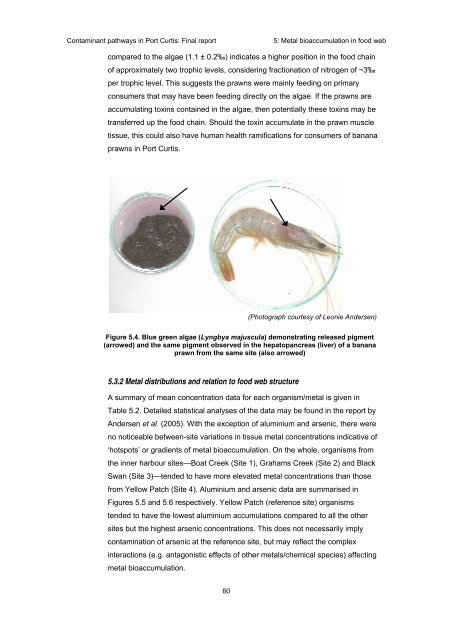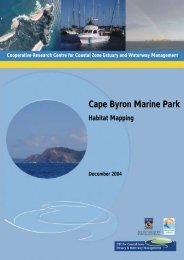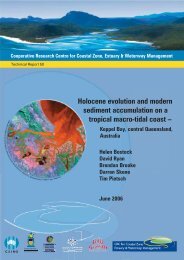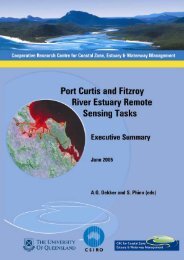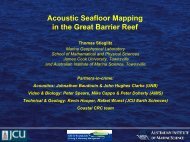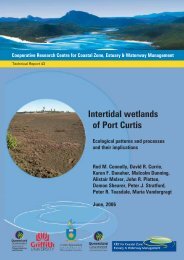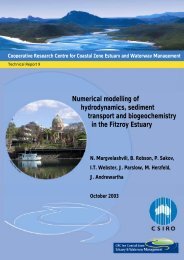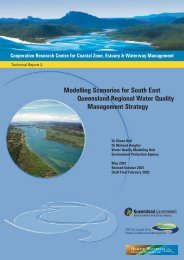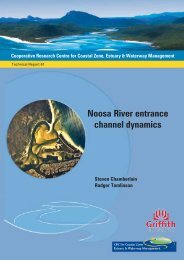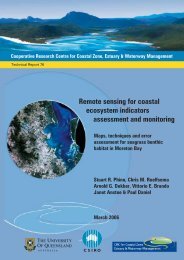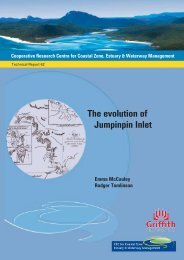Contaminant pathways in Port Curtis: Final report - OzCoasts
Contaminant pathways in Port Curtis: Final report - OzCoasts
Contaminant pathways in Port Curtis: Final report - OzCoasts
Create successful ePaper yourself
Turn your PDF publications into a flip-book with our unique Google optimized e-Paper software.
<strong>Contam<strong>in</strong>ant</strong> <strong>pathways</strong> <strong>in</strong> <strong>Port</strong> <strong>Curtis</strong>: F<strong>in</strong>al <strong>report</strong>5: Metal bioaccumulation <strong>in</strong> food webcompared to the algae (1.1 ± 0.2‰) <strong>in</strong>dicates a higher position <strong>in</strong> the food cha<strong>in</strong>of approximately two trophic levels, consider<strong>in</strong>g fractionation of nitrogen of ~3‰per trophic level. This suggests the prawns were ma<strong>in</strong>ly feed<strong>in</strong>g on primaryconsumers that may have been feed<strong>in</strong>g directly on the algae. If the prawns areaccumulat<strong>in</strong>g tox<strong>in</strong>s conta<strong>in</strong>ed <strong>in</strong> the algae, then potentially these tox<strong>in</strong>s may betransferred up the food cha<strong>in</strong>. Should the tox<strong>in</strong> accumulate <strong>in</strong> the prawn muscletissue, this could also have human health ramifications for consumers of bananaprawns <strong>in</strong> <strong>Port</strong> <strong>Curtis</strong>.(Photograph courtesy of Leonie Andersen)Figure 5.4. Blue green algae (Lyngbya majuscula) demonstrat<strong>in</strong>g released pigment(arrowed) and the same pigment observed <strong>in</strong> the hepatopancreas (liver) of a bananaprawn from the same site (also arrowed)5.3.2 Metal distributions and relation to food web structureA summary of mean concentration data for each organism/metal is given <strong>in</strong>Table 5.2. Detailed statistical analyses of the data may be found <strong>in</strong> the <strong>report</strong> byAndersen et al. (2005). With the exception of alum<strong>in</strong>ium and arsenic, there wereno noticeable between-site variations <strong>in</strong> tissue metal concentrations <strong>in</strong>dicative of‘hotspots’ or gradients of metal bioaccumulation. On the whole, organisms fromthe <strong>in</strong>ner harbour sites—Boat Creek (Site 1), Grahams Creek (Site 2) and BlackSwan (Site 3)—tended to have more elevated metal concentrations than thosefrom Yellow Patch (Site 4). Alum<strong>in</strong>ium and arsenic data are summarised <strong>in</strong>Figures 5.5 and 5.6 respectively. Yellow Patch (reference site) organismstended to have the lowest alum<strong>in</strong>ium accumulations compared to all the othersites but the highest arsenic concentrations. This does not necessarily implycontam<strong>in</strong>ation of arsenic at the reference site, but may reflect the complex<strong>in</strong>teractions (e.g. antagonistic effects of other metals/chemical species) affect<strong>in</strong>gmetal bioaccumulation.60


